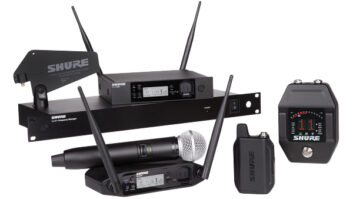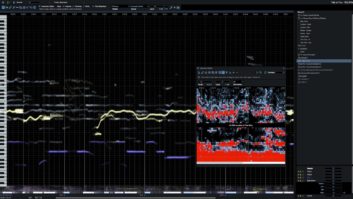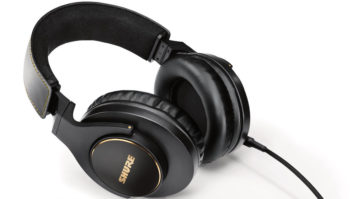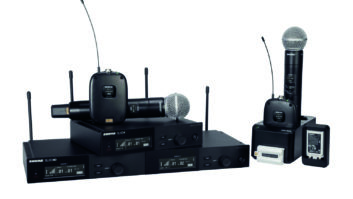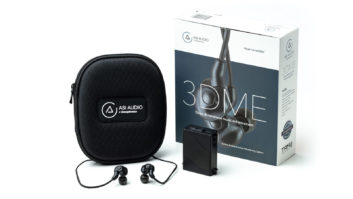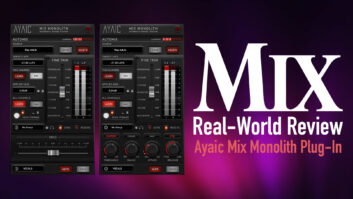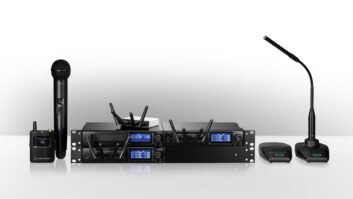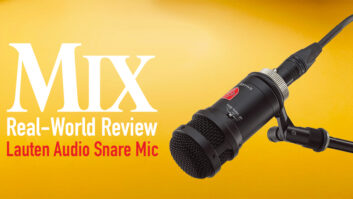
| MIX VERDICT: SHURE GLXD24R+/SM58 HANDHELD WIRELESS AND GLXD14R+ INSTRUMENT WIRELESS |
| THE TAKEAWAY: “The GLX-D+ is a great solution for local and touring musicians, corporate, or house-of-worship applications requiring modest channel counts” |
| COMPANY: Shure Incorporated • www.shure.com PRICE: GLXD24R+/SM58: $649.00; GLXD14R+: $599.00. GLXD+FM Dual Band Frequency Manager: $549 PROS: • Excellent RF performance and audio quality. • Long battery life. • Easy to use. CONS: • Maximum channel count may be insufficient for creating large RF systems. |
As the RF landscape becomes increasingly crowded, wireless manufacturers diligently seek ways for audio pros to make efficient use of the available spectrum. Shure’s GLX-D+ Dual Band Digital Wireless System plants a foot firmly in that direction, operating in both the 5.8 GHz band and the popular 2.4 GHz band — effectively doubling the RF bandwidth and increasing the number of channels that can be operated simultaneously.
GLX-D+ systems are available in a variety of configurations, with handheld or bodypack transmitters, and table-top, rack- mount or guitar pedal receivers. An assortment of miniature Shure microphones are offered for use with the bodypack, including headset, lavalier and clip-on mics.
For this review, Shure sent Mix a GLXD1+ Digital Wireless Bodypack transmitter with WA302 instrument cable, a GLXD2+ Digital Wireless Handheld transmitter with SM58 capsule (Beta 58 and Beta 87A capsules are options), and a GLXD4R+ rack receiver.
A GLX-D+ system can be used in one of three modes: 2.4 GHz only, 5.8 GHz only, and 2.4 and 5.8 GHz (“best band”). The latter is the factory default and was the mode I used for most of my review. Each mode has several RF groups, and the user manual provides a guide regarding which mode and group to use based upon the number of receivers in use, as well as the local RF environment.
When running multiple receivers simultaneously, all must be set to the same group; when using more than two receivers, Shure suggests using the optional GLXD+FM Dual Band Frequency Manager. The Frequency Manager can connect up to six GLXD4R+ receivers, creates a shared group of frequencies for all receivers to use, and automatically assigns a frequency to each receiver (!). A maximum of three Frequency Managers may be combined to build a system with a typical channel count of 11, or up to 16 under optimal RF conditions.
OUT OF THE BOX
When I unpacked the GLX-D+ components, I was initially alarmed that there was no battery charger included; then I noticed the battery bay on the front panel of the GLXD4R+ receiver. This— combined with the ability for both transmitters to charge a battery via the USB-C port—means no need for external chargers (the USB-C port is also used for firmware updates).
Transmitters are powered using a Shure SB904 lithium-ion rechargeable battery. A full charge takes three hours and allows a transmitter to run up to 12 hours of operation (more than 11 hours in 5.8 GHz mode). At the bottom of the GLXD2+ bodypack is a locking door to the battery compartment; the GLXD1+ uses the typical rotating sleeve to gain access to the battery.
The GLXD2+ handheld transmitter is solid (if somewhat unremarkable), while the GLX-D1+ bodypack is built like a little brick. Both transmitters have a minimum complement of controls: on/off switches on the outside, and link buttons, battery compartments, and USB-C ports under the covers. The GLXD1+ uses a locking TA4-to- TS cable for instrument input (thank you, Shure). Notably absent from both transmitters is a gain control. Instead, gain is set at the front panel of the receiver, simplifying setup. One of the features I liked about the system is that gain can be set individually for each transmitter, and is automatically recalled when a transmitter is turned on.
Combined with the fact that multiple transmitters can be linked to a single receiver (though Shure warns that only one transmitter should be powered on at a time), this feature enables you to establish a consistent gain structure when using bodypacks on a guitar or bass rig with multiple instruments that have different output levels. The transmitters also feature a built-in antenna and a multi-color LED indicating transmitter status. Transmission power is 10 mW maximum, and transmission is Shure proprietary digital with a range of 100 feet.
BE RECEPTIVE
The Shure GLXD4R+ receiver is a compact unit (half-space, 1RU) that can be racked alone or in pairs using the included hardware. Front-panel features include a power switch, LCD screen, indicator lights for RF status and data sync; buttons for gain up/down, group, link and channel; and the battery charging bay with charge status indicator. The charging indicator lights red while charging, flashes green at 90 percent, and lights steady green at full charge; a spare battery may be charged in the bay while the system is in use.
Around the back, the GLXD4R+ provides threaded jacks for two half-wave antennas (included), a power supply jack with a threaded locking collar for the DC plug, USB-C port for firmware updates, XLR output with mic/line level switch, and a 1⁄4-inch TRS instrument/aux output jack.
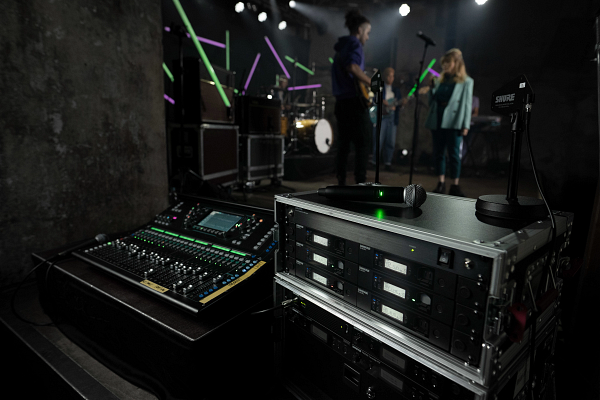
The GLX-D+ system couldn’t be easier to use. Turn on the receiver, use the Group button to set the channel group (if necessary), then press the Channel button to initiate auto scan. Turn on the transmitter, and the blue RF indicator on the receiver will flash until the receiver and transmitter are linked, then remain lit. The transmission channel will automatically be relayed from the receiver to the transmitter. Linking happens only on the initial use; when the devices are subsequently powered up, they link automatically. In the event that the devices do not auto-link, press the Link button on the receiver.
Receivers and transmitters may be locked to prevent unwanted changes to system settings.
Moments after powering on the transmitter, the receiver LCD will show battery life in hh:mm, and gain settings (when using our system, the battery gauge showed as high as 14 hours). A five-segment meter shows audio level from the transmitter, and briefly holds “OL” if the audio level reaches clipping. No menu paging is required for operation—another plus. Shure suggests turning on any nearby Wi-Fi devices that will be used during the performance before turning on GLX-D+ components, which brings us to…
THE ROAD TEST
I took the GLX-D+ on the road, mostly using the instrument pack but also using the handheld transmitter. The first time I used it was at the America Gardens Theatre in Epcot at Disney World, Orlando. What better place to evaluate a wireless than this veritable cesspool of RF activity? When advancing these shows, I mentioned to the production manager that I’d bring the GLX-D+, and was warned that the RF environment on-site was very hostile. Perfect. I set up the system for use with an electric guitar and held my breath at the start of soundcheck. Not a hiccup to be heard, not at soundcheck or across six shows (three per day). More importantly, the guitar sounded great.
Back-story: Prior to the shows—while I was still at home—I did an A/B comparison between a guitar connected to the GLXD1+ bodypack versus a hard wire going into an amplifier, so that I could establish a “unity gain” setting on the pack, i.e., a setting where gain through the GLX-D+ was the same as using a wire into the amp. A gain setting of -18 did the trick, producing almost exactly the same level as the wired connection (I’d have set the gain a dB or two lower on the GLXD4R+, but -18 was the lowest setting). I felt that the sound of the guitar through the GLXD1+ might have been a hair brighter than the wire, but the GLX-D+ sounded very close to a cable.
Solid State Logic Connex – A Mix Real-World Review
When I used the GLX-D+ on electric bass at several other locations (casino showrooms, areas that also had high levels of RF activity), there was no evidence of transmission artifacts such as compression/ expansion, which can be heard when using systems of lesser pedigree. Bottom end was tight, and—as with the guitar—I never heard dropouts or interference.
Using the GLXD2+ handheld transmitter with the GLXD4R+ gain set to -3 dB and the output switch set to microphone level, the receiver output almost the same level as that of a wired SM58. I had the chance to A/B a wired SM58 with the GLXD2+, and it was tough to tell them apart.
Judging from the performance of the GLX-D+ system, Shure engineers have certainly done their homework. The system is extremely user-friendly, sounds great and provides excellent RF performance. Power RF users may cite the channel count and lack of networking as limitations, but the GLX-D+ is a great solution for local and touring musicians, corporate, or house-of-worship applications requiring modest channel counts while providing great RF and audio performance.
